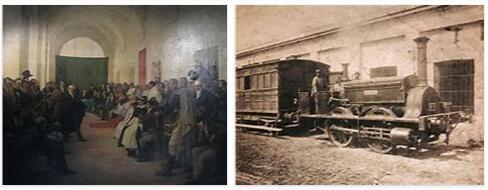According to beautypically.com, the sec. XVIII, in fact, opens, in the history of the Plata, with a new and not least lawsuit for the Colonia del Sacramento. The governor Juan Valdes de Inclán drove the Portuguese again; but these not only returned there under the treaty of Utrecht, but also tried to expand along the eastern bank of the Plata, to reinforce the positions of Sacramento (1720). The new governor Zavala, with the help of forces from Tucumán and Paraguay, as well as the usual Indians, besieged the works of the Portuguese, who had to abandon them in January 1724. The governor of Buenos Aires took possession of the place, and there in 1726 he founded the city of Montevideo, populating it with settlers brought in from the Canaries and Paraguay. The military merits of Zavala were not sufficient to make him acquitted of accusation of inability to stop smuggling, so that he was exonerated and replaced, in 1734, by Miguel Salcedo. Which, in turn, did not fail to lay siege to the Colonia del Sacramento, which the Portuguese, foresighted by past misfortunes, had strongly equipped. To get rid of this bone of contention in overseas politics, the Spanish minister Carbajal secretly negotiated, in 1750, the exchange of Sacramento: this colony would pass to the crown of Spain, and Portugal would have the Rio Grande del Sud in return., from Santa Caterina to the border of Paraguay, including the Jesuit missions of upper Uruguay and Guayra. When the treaty began to be implemented, indignation was general in the Spanish countries of America: the new governor of Buenos Aires, José de Antonaegui, refused to execute it, if the king had not first been informed by him of all the clauses. It seems, in fact, that Ferdinand VI and the other ministers ignored the true nature of the treaty negotiated by the Carbajal, so that, among the protests coming from the colonies, among the intervention of King Charles of Naples, and then for the death of the Carbajal himself (1754), it was decided to send Lieutenant General Pedro de Cevallos, equipped with full powers, to the site to understand the situation. Cevallos, who arrived in Buenos Aires in 1757, found that the Spanish and Portuguese commissioners had begun work on the execution of the treaty and, having found resistance in the guaranís, they had massacred it. Therefore he immediately embarked for Europe the Spanish commissioner, Marquis of Valdelirios, member of the Council of the Indies, had the Portuguese commissioner, Freire de Andrada, with his troops withdraw, and in 1759 declared the treaty null, except for the approval of the king. of Spain, then Charles III. And even at this point the fight was not over: it reared when, in 1762, Cevallos reoccupied Sacramento, and defended it victoriously against the English admiral Mac-Denara: this too was a sterile victory, like that of José de Garro in 1680, since for peace of Paris of 1763 Sacramento was still demoted to Portugal. After the expulsion of the Jesuits (1767), quickly carried out by the governor Francesco di Paola Bucarelli, who was also noted (1769) for the recovery of the Maluine islands, illegally occupied by the English, the struggle was rekindled again around the Colonia del Sacramento, which, as we have seen, has been the fulcrum of Plato’s history for a century. In 1776 Charles III elevated the governorship of Plata to vice-kingdom, appointed Pedro deC evallos, and he, in November of that year, left Cadiz with a mighty fleet of 19 ships of the line and aboard about 10,000 soldiers. In February 1977 he occupied Santa Caterina, descended towards the Plata and took possession, without a shot being fired, of the Colonia del Sacramento. He then returned to the Rio Grande to complete the re-establishment of the Spanish borders, when the treaty of Sant’Idelfonso finally determined that the contested Sacramento would remain in the crown of Spain and the Rio Grande in that of Portugal. The following year Cevallos, due to protests by the Portuguese, who judged him too rigid in determining the borders, was recalled to Spain and replaced with J uan J osé de V ertiz.
The vice-kingdom was thus firmly constituted: the second step towards autonomy, the first being represented by the separation of Paraguay. In 1782, applying the descenting theories of Cevallos, the territory of the viceroyalty was divided into eight administrations, at the head of each of which was a governor-intendant. They were: 1st Buenos Aires (bishopric), with the southern territories, Montevideo, Corrientes and Santa Fe; 2) Paraguay (bishopric); 3) Salta del Tucumán (bishopric) with the central provinces of Argentina; 4) Córdoba del Tucumán, with San Luis, San Juan and la Rioja; 5) Santa Cruz de la Sierra (bishopric) or Cochabamba; 6) la Paz (bishopric); 7) Presidency of Charcas (Chuquisaca) (archbishopric); 8) Potosí. The following year the military governorates of Moxos (Mojos) and Chiquitos were aggregated to the viceroyalty.edro deC evallos(1777-78), J osé de V ertiz (1778-84), marquis of L oreto (1784-89), N icolas de A rredondo (1789-95), P edro M elo de P ortugal YV illena (1795-97), A ntonio O laguer Feliú (1797-99), G abriel A vilés de F ierro (1799-1801), J oaquín del P ino (1801-4), marquis of S obremonte (1804-7), Jacques de L iniers (1807-9), B altazar H idalgo de C isneros (1809-10). Of some of them we will have to give a longer speech, but first it will be worthwhile to take a look at the general conditions of the country and the public spirit.
